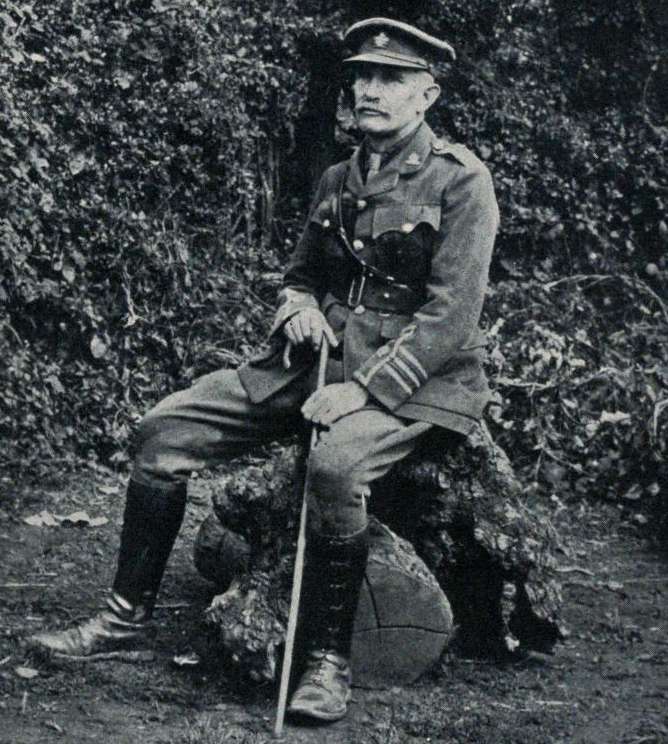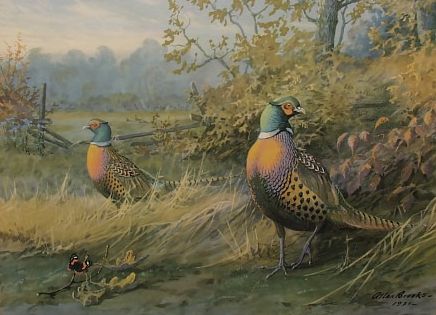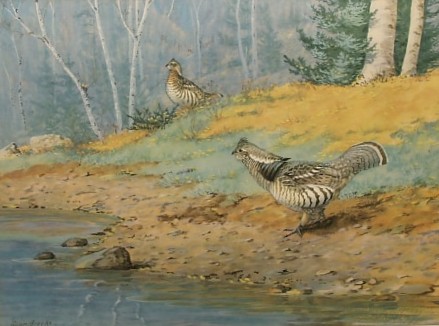
Major Brooks portrait
| BRITISH COLUMBIA ARTISTS |

In the fall of 1894 Brooks and his brother Ted returned to Chilliwack in time for fall duck hunting. Brooks then began one of the most amazing mixed careers in the history of British Columbia. He shot birds for food, for the market, and for collectors. He also hunted and trapped mammals, ranging in size from the smallest of shrews up to big game. He drew and painted birds and wildlife, and began selling his artwork as illustrations for a number of major publications on birds, as well as for sporting and recreational periodicals.
British Columbia was almost a scientific wilderness at this time, and Brooks discovered many new species of animals that he sold to collectors as far away as England, who published the information in scientific journals. He sold fleas, for example, to Charles Rothschild at the Tring Zoological Museum, in Hertfordshire, and is credited with providing material either wholly or in part responsible for the identification of fifteen new species of fleas. One of these species, that Brooks curried from the fur of a weasel, is named Nearctopsylla brooksi after him.
He was a charter member of the B.C. Society of Fine Arts when it was founded in 1908, and had four paintings in its First Annual Exhibition in April 1909.
In 1911 Brooks loaned nine paintings on request of the Provincial Museum of B.C. for exhibition in the International Sportsman's Exhibition in Vienna. One of the paintings was stolen, perhaps because none of them were for sale.
Brooks also prospected and ran trap-lines, travelling extensively throughout southern British Columbia, on foot and by horse. He was an extremely accomplished hunter, with a large collection of rifles and shot-guns, and competed regularly in shooting matches, eventually culminating with shooting as a member of the Canadian team in the championships at Bisley, England, just as World War One broke out.
The war started just as Brooks was reaching full maturity as an ornithologist, an illustrator, a painter, a hunter, a collector and trapper, and a "crack shot". He had by that time illustrated the major work "Birds of Washington" and others, and was poised for a top-level career as an illustrator. Regardless, at the age of 45 he immediately volunteered into a Scottish regiment. He was soon sent back to Canada, though, when it was discovered that he already held an officer's commission in the Canadian Militia.
He sailed back to Europe in October 1914, going to war. He was promoted from Lieutenant to Captain in April 1915, and a month later to Major, a rank he held until the end of hostilities. December 21 1915 he was appointed Instructor of Snipers School, 1st Canadian Division. In March 1917 he was appointed Chief Instructor of the 2nd Army Sniping School.
Brooks did not simply teach behind the lines and stay out of harm's way during the war. He was mentioned in dispatches three times, on November 30, 1915, November 13, 1916, and March 16 1919. He was awarded the D.S.O.for his actions ahead of the front lines during an assault on the Drocourt-Queant line in Arras, with the 11th Brigade of the Canadian Expeditionary Force, in 1918, as the Allies began their final offensive against the German army.
The citation of the Deed of Action for which Brooks received the Distinguished Service Order reads as follows:
| For conspicuous gallantry in the operations of 2nd and 3rd September 1918 in front of Arras. As brigade observing office he showed great daring and initiative, pushing forward at all times with the most advance troops under the heaviest fire. Taking a wire with him he kept brigade headquarters well informed of the situation and enabled the commander to make decisions that saved many lives. When the enemy was retiring he pushed forward 500 yards in front of the infantry and telephoned back information from a long distance in front of our advance. During the two days he personally killed twenty of the enemy by sniping shot. |
Another conspicuous action was a two-day sniping episode where Brooks and his bat-man hid themselves in a slag heap closely overlooking the German lines in order to snipe at them. They each took 100 rounds of ammunition. The bat-man was killed almost immediately by return fire, but Brooks remained there for two days until he had fired all 200 rounds of ammunition they had taken with them. With his accuracy one can only imagine that he killed a large number of the enemy.
Brooks almost "went west" when he walked into a trap set by the Germans in 1917. He was caught in relatively open ground, but the Germans saw that he was a staff officer and decided to take him prisoner. This gave Brooks time to drop to the ground and crawl towards a nearby bombed-out tank. He was able to crawl into it, and using it as a sniping position defended himself successfully until a shell apparently exploded on or near the tank. He was knocked unconscious, but was relatively uninjured except for damaged hearing. The advance had by this time gone by him, and he was taken to the field hospital, where he asked a friend of his to go back to the field and see how many dead enemy soldiers he could find. Apparently there were at least twelve dead Germans, every one of them shot through the head.
Brooks, however, was now "safely wounded", and was out of the war for good. He began to make his way out of France, to England, and finally back to Canada, landing on March 30, 1919. He arrived back at his home in Okanagan Landing on April 15, 1919, to take up his life exactly where he had left off four and a half years ago. It seems amazing that he went from being an excellent hunter and painter to being a deadly killer of men, and then seemingly effortlessly taking up the paintbrush again.
Brooks continued to illustrate extensively, including the massive four-volume Birds of California, issued in 1923 with 110 colour plates by Brooks. He also illustrated Ducks of the World, Birds of Western Canada and Birds of Canada, and contributed many illustrations to other books and to National Geographic magazine.


|
BROOKS, Allan Okanagan Landing, B.C. Painter (water color, oil); Drawing; Illustrator - Born Etawah, India, Feb. 15, 1869. |
Allan Brooks was, in sum, an amazing man. Not only was he a man of almost continuous action and energy, he left behind a large number of detailed notebooks, daily and annual bird count summaries, daily diaries, detailed sketchbooks, and a large number of personal letters. It is possible to track his movements through the forests and rivers of B.C. almost day to day for a number of years. The species and quantities of wildlife that he saw and recorded are to a large part now gone, with his detailed records alone remaining to tell us what we have lost.
A number of short biographies and memorials were written on Brooks through the years, but by far the most comprehensive is Allan Brooks - Artist Naturalist, by Hamilton M. Laing, 1979, B.C. Provincial Museum Special Publication 3. Laing was a friend of Brooks' for a number of years and so is able to speak of him personally as well as from his records and artwork.
SOLO EXHIBITIONS
| DATE | EXHIBITION | LOCATION |
| 1949 Aug. 2 - 21 | Solo Exhibition (Memorial?) | Vancouver Art Gallery |
| DATE | EXHIBITION | ARTWORK |
| 1909 April 20 - 28 | BCSFA First Annual Exhibition | Heron |
| Study of Young Cougar | ||
| Summit of the Selkirks, Caribou | ||
| Morning Mists, Wapiti | ||
| 1929 May 18 - June 8 | BCSFA 21st Annual Exhibition | The Raven |
| 1929 October | BCAL Citizens' Loan of W/C | The Raven | The Gerfalcon |
| 1950 April 25 - May 14 | BCSA 40th Annual Exhibition | Mallards |
PROFILES OF A HERITAGE - Images of Wildlife by British Columbia Artists
Published by Centennial Wildlife Society of British Columbia and Liane Davison
1987, no ISBN, Traveling Exhibition Curated by Liane Davison
Sofcover, not paginated, works illustrated in colour and black & white
Includes Foreword by Patricia Bovey, Introduction, biographies, artist statements
Includes early artwork by Alan Brooks.
THE FINE ARTS IN VANCOUVER, 1886 - 1930 (refer to THOM69)
ISLAND ARTS AND CRAFTS SOCIETY - LIST OF EXHIBITORS
ARTISTS IN CANADA 1982 - UNION LIST OF ARTISTS' FILES (refer to AIC82)
A DICTIONARY OF CANADIAN ARTISTS (refer to M)
THE CANADIAN ENCYCLOPEDIA (refer to CE00)
ENCYCLOPEDIA OF BRITISH COLUMBIA (refer to EBC00)
BIOGRAPHICAL INDEX OF ARTISTS IN CANADA (refer to BIAC03)
4 references cited for Brooks.
VANCOUVER PUBLIC LIBRARY - B.C. ARTISTS FILES (refer to VPL)
CITY & PROVINCIAL DIRECTORIES 1923-24 Okanagan Landing (refer to DIR)
Allan Brooks, Naturalist and Artist (1869-1946): the Travails of an Early Twentieth
Century Wildlife Illustrator in North America
https://www.erudit.org/fr/revues/scientia/2008-v31-n1-2-scientia2574/019758ar.pdf
B.C. VITAL STATISTICS ON-LINE marriage, death (refer to BCVS)
Allan Brooks - Audubon of the West by G.E. Valentine, "Vancouver Province", November 22, 1946